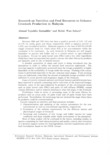Research on Nutrition and Feed Resources to Enhance Livestock Production in Malaysia
Tropical agriculture research series : proceedings of a symposium on tropical agriculture researches
| ISSN | 03889386 |
|---|---|
| 書誌レコードID(総合目録DB) | AA00870529 |

本文フルテキスト
tars25-_9-25.pdf2.35 MB
Between 1988 and 1989 there has been a positive growth of 3.58, 1.92 and 22.17% for cattle, goats and sheep, respectively whilst a negative growth of 3.16% was recorded in buffalo. Malaysia imports to the tune of $M 631,316,500 ringgit livestock feeds for which about 95% is for non-ruminants whilst the remainder is for ruminants. As such, livestock in Malaysia are still largely dependent on pasture and fodder and to a certain extent on agro-industrial by-products. Except for palm kernel cake (PKC) and a few other ingredients which have been incorporated into poultry rations, the other fibrous by-products are basically used in situ, in limited amount.
A sizeable population of sheep and cattle is being introduced into the plantations in order to utilize the natural feed resources underneath. The carrying capacity is judiciously monitored since the forage availability is highly dependent on the availability of forage under the canopy. Flushing with concentrates is performed especially in the pre- and post-natal stages. If the stocking rates are judiciously controlled, the amount of palatable forage available will be sufficient to cover growth and pregnancy stages of the livestock.
Cases of toxicity (mineral and anti-nutritional factors) and deficiencies have been reported in animals consuming native and some of the improved forages.
Similarly, some of the agro-industrial by-products of the oil-extracted meals such as palm kernel cake (PKC) and palm oil mill effluent (POME), caused vitamin deficiency and/or mineral imbalances when fed singly to the livestock.
Preliminary trials in terms of processing some of the more fibrous byproducts such as cocoa pods, oil palm trunk and oil palm fronds have been performed. Nevertheless, the technology has not attained the stage where these by-products could be commercialized.
Current research on nutrition and feed resources includes :
1) Characterization and updating of the various parameters for the nonconventional as well as conventional ingredients, respectively.
2) Evaluation of the nutrient requirements for the different species and physiological stages of livestock.
3) Screening and evaluation of new forage and fodder species for range conditions and those suitable under shade environment in the plantation.
Most of these studies will be continued in the future, including studies on spectro computing for feed characterization and quality control, plus formation of a decision support system for feed ingredients, nutrient requirements and for feed formulation, based on the INFIC format.
A sizeable population of sheep and cattle is being introduced into the plantations in order to utilize the natural feed resources underneath. The carrying capacity is judiciously monitored since the forage availability is highly dependent on the availability of forage under the canopy. Flushing with concentrates is performed especially in the pre- and post-natal stages. If the stocking rates are judiciously controlled, the amount of palatable forage available will be sufficient to cover growth and pregnancy stages of the livestock.
Cases of toxicity (mineral and anti-nutritional factors) and deficiencies have been reported in animals consuming native and some of the improved forages.
Similarly, some of the agro-industrial by-products of the oil-extracted meals such as palm kernel cake (PKC) and palm oil mill effluent (POME), caused vitamin deficiency and/or mineral imbalances when fed singly to the livestock.
Preliminary trials in terms of processing some of the more fibrous byproducts such as cocoa pods, oil palm trunk and oil palm fronds have been performed. Nevertheless, the technology has not attained the stage where these by-products could be commercialized.
Current research on nutrition and feed resources includes :
1) Characterization and updating of the various parameters for the nonconventional as well as conventional ingredients, respectively.
2) Evaluation of the nutrient requirements for the different species and physiological stages of livestock.
3) Screening and evaluation of new forage and fodder species for range conditions and those suitable under shade environment in the plantation.
Most of these studies will be continued in the future, including studies on spectro computing for feed characterization and quality control, plus formation of a decision support system for feed ingredients, nutrient requirements and for feed formulation, based on the INFIC format.
| 刊行年月日 | |
|---|---|
| 作成者 | Ahmad Tajuddin Zainuddin Mohd. Wan Zahari |
| 公開者 | Japan International Research Center for Agricultural Sciences |
| 巻 | 25 |
| 開始ページ | 9 |
| 終了ページ | 25 |
| 言語 | eng |
